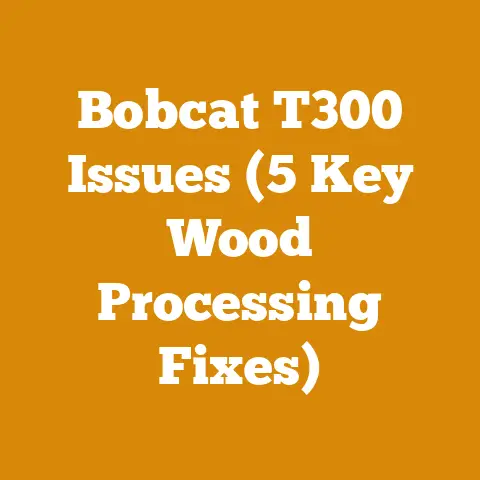Carbide Chainsaw Blades Benefits & Drawbacks (5 Pro Tips)
Imagine a chainsaw blade as a tireless workhorse, relentlessly chewing through wood. Now picture that workhorse fitted with teeth of diamond-hard carbide, promising increased lifespan and performance. Sounds fantastic, right? But like any shiny new tool, carbide chainsaw blades come with their own set of quirks and considerations. In this article, I’ll delve into the world of carbide chainsaw blades, exploring their benefits, drawbacks, and offering five pro tips to help you decide if they’re the right choice for your woodcutting needs. I’ll also share my experiences, the good and the not-so-good, from years spent felling trees and processing firewood. Let’s get started.
Carbide Chainsaw Blades: Benefits & Drawbacks (5 Pro Tips)
Carbide chainsaw blades represent a significant advancement in cutting technology. But are they worth the investment? Understanding their strengths and weaknesses is crucial for making an informed decision. I remember the first time I saw a carbide chain in action – it sliced through a knotty oak log like butter. I was immediately intrigued, but also cautious. Experience has taught me that every tool has its place, and carbide chains are no exception.
The Alluring Benefits of Carbide Chainsaw Blades
Carbide chains are not your average cutting tool; they boast a range of advantages that can significantly impact your work.
- Extended Lifespan: This is the primary draw for most users. Carbide is an incredibly hard material, far more resistant to wear than traditional steel. A carbide chain can last 3 to 5 times longer than a standard chain, even when cutting abrasive materials like dirty wood or reclaimed timber. I’ve personally seen carbide chains maintain their sharpness through projects that would have dulled several standard chains.
- Enhanced Durability: Carbide teeth are less prone to chipping or breaking, especially when encountering hidden debris like nails or staples in reclaimed wood. This durability translates to less downtime for sharpening and chain replacement. In my experience, this is a huge advantage when working on-site, where time is money.
- Superior Cutting Performance in Abrasive Conditions: Carbide chains excel when cutting through dirty, sandy, or even slightly rocky wood. The hardness of the carbide allows it to maintain its edge in conditions that would rapidly dull a standard chain. This is particularly beneficial for those working with salvaged lumber or in environments where keeping the wood clean is challenging. I once used a carbide chain to cut through a pile of old railroad ties, a task that would have destroyed a regular chain in minutes.
- Reduced Sharpening Frequency: Due to their exceptional hardness, carbide chains require significantly less frequent sharpening than standard chains. This saves time and money on sharpening equipment and services. While the initial investment in a carbide chain is higher, the reduced sharpening costs can offset the difference over time.
- Potential for Cutting Harder Materials: While not designed for cutting metal, carbide chains can sometimes handle incidental contact with embedded nails or screws without immediate damage. This can be a lifesaver when working with reclaimed wood where hidden fasteners are a common issue. However, repeated contact with metal will eventually damage the carbide teeth.
The Not-So-Shiny Drawbacks of Carbide Chainsaw Blades
Despite their impressive benefits, carbide chainsaw blades also have some drawbacks that need to be considered.
- Higher Initial Cost: Carbide chains are significantly more expensive than standard chains, often costing two to three times as much. This higher upfront cost can be a barrier for some users, especially those on a tight budget.
- Specialized Sharpening Requirements: Sharpening carbide chains requires specialized equipment and techniques. Standard chainsaw sharpening tools are not suitable for carbide. This means you’ll either need to invest in a carbide-specific sharpener or pay a professional to sharpen your chain. I’ve learned the hard way that attempting to sharpen a carbide chain with a standard file is a recipe for disaster.
- More Brittle than Standard Chains: While carbide is incredibly hard, it’s also more brittle than steel. This means that carbide teeth are more susceptible to chipping or breaking if subjected to excessive force or impact. This is especially true when cutting frozen wood or encountering large embedded objects.
- Potential for Increased Kickback: Some users report that carbide chains can be more prone to kickback than standard chains, especially when cutting at an angle or in tight spaces. This is likely due to the aggressive cutting action of the carbide teeth. It’s crucial to use proper chainsaw safety techniques when using a carbide chain.
- Heavier Weight: Carbide chains tend to be slightly heavier than standard chains, which can increase operator fatigue, especially during prolonged use. This difference in weight may not be noticeable for short tasks, but it can become significant over a full day of cutting.
Cost Analysis: Carbide vs. Standard Chainsaw Blades
To make an informed decision, it’s essential to analyze the cost implications of choosing carbide versus standard chainsaw blades. I’ve put together a cost analysis based on my experiences and industry averages. Keep in mind that these are estimates and actual costs may vary depending on your location and specific usage.
Assumptions:
- Chainsaw Usage: 50 hours per year
- Standard Chain Lifespan: 10 hours
- Carbide Chain Lifespan: 40 hours
- Standard Chain Cost: $30
- Carbide Chain Cost: $90
- Standard Chain Sharpening Cost: $5 per sharpening (every 2 hours)
- Carbide Chain Sharpening Cost: $20 per sharpening (every 8 hours)
Standard Chain Costs:
- Chain Replacements: 50 hours / 10 hours per chain = 5 chains per year
- Chain Replacement Cost: 5 chains * $30 per chain = $150 per year
- Sharpening Frequency: 50 hours / 2 hours per sharpening = 25 sharpenings per year
- Sharpening Cost: 25 sharpenings * $5 per sharpening = $125 per year
- Total Standard Chain Cost: $150 + $125 = $275 per year
Carbide Chain Costs:
- Chain Replacements: 50 hours / 40 hours per chain = 1.25 chains per year (round up to 2 for practical purposes)
- Chain Replacement Cost: 2 chains * $90 per chain = $180 per year
- Sharpening Frequency: 50 hours / 8 hours per sharpening = 6.25 sharpenings per year (round up to 7 for practical purposes)
- Sharpening Cost: 7 sharpenings * $20 per sharpening = $140 per year
- Total Carbide Chain Cost: $180 + $140 = $320 per year
Analysis:
In this scenario, the annual cost of using carbide chains is slightly higher ($320) than using standard chains ($275). However, this analysis doesn’t account for factors like:
- Downtime: The reduced need for chain replacements and sharpenings with carbide chains can save significant time, which translates to increased productivity and potential cost savings.
- Abrasive Conditions: If you’re frequently cutting dirty or abrasive wood, the lifespan of standard chains will be significantly reduced, making carbide chains a more cost-effective option. I’ve found this to be especially true when working with reclaimed lumber or storm-damaged trees.
- Convenience: The reduced sharpening frequency of carbide chains can be a significant convenience, especially for those who don’t have the time or skills to sharpen chains themselves.
Conclusion:
While the initial cost of carbide chains is higher, their extended lifespan and reduced sharpening frequency can make them a cost-effective option in the long run, especially for those who frequently cut abrasive materials or value convenience. However, if you primarily cut clean wood and don’t mind sharpening your chain regularly, standard chains may be a more economical choice.
5 Pro Tips for Using Carbide Chainsaw Blades
Based on my experience, here are five pro tips to help you get the most out of your carbide chainsaw blade:
- Start with a Sharp Chain: A sharp chain is essential for efficient cutting and safety. Before using a new carbide chain, have it professionally sharpened to ensure that all the teeth are properly aligned and sharpened to the correct angle. This will maximize its cutting performance and lifespan. I always recommend getting a new chain sharpened, even if it claims to be “pre-sharpened” – it’s a worthwhile investment.
- Use the Right Cutting Technique: Carbide chains are designed for a smooth, consistent cutting action. Avoid forcing the chain through the wood, as this can damage the teeth. Let the chain do the work, and maintain a steady pressure. I’ve found that a slow, deliberate approach is often more effective than trying to rush the cut.
- Keep the Chain Clean: Dirt and debris can accelerate wear on carbide teeth. Regularly clean your chain with a brush and solvent to remove any buildup. This will help to maintain its cutting performance and extend its lifespan. I always carry a small brush and solvent with me when working on-site.
- Avoid Contact with Metal: While carbide chains can sometimes handle incidental contact with metal, repeated contact will damage the teeth. Be extra cautious when cutting reclaimed wood or in areas where hidden fasteners may be present. I always use a metal detector before cutting reclaimed lumber to avoid damaging my chain.
- Sharpen Properly: Sharpening carbide chains requires specialized equipment and techniques. Use a carbide-specific sharpener or take your chain to a professional sharpening service. Attempting to sharpen a carbide chain with a standard file will likely damage the teeth. I invested in a carbide sharpener a few years ago, and it’s been a worthwhile investment.
Understanding Wood Species and Their Impact on Chain Wear
The type of wood you’re cutting significantly impacts the wear and tear on your chainsaw chain, whether it’s a standard or carbide blade. Different wood species have varying densities, hardness, and resin content, all of which affect how quickly a chain dulls.
- Hardwoods vs. Softwoods: Hardwoods like oak, maple, and hickory are denser and more abrasive than softwoods like pine, fir, and cedar. Cutting hardwoods will generally dull a chain faster than cutting softwoods. I’ve noticed a significant difference in chain wear when switching between cutting oak firewood and processing pine logs.
- Resin Content: Wood species with high resin content, such as pine and fir, can cause resin to build up on the chain, reducing its cutting efficiency and accelerating wear. Regularly cleaning the chain with a solvent is essential when cutting resinous woods. I’ve found that using a citrus-based solvent is particularly effective for removing resin buildup.
- Dirty Wood: As mentioned earlier, dirt, sand, and other abrasive materials can quickly dull a chainsaw chain. This is especially true when cutting wood that has been lying on the ground or that has been exposed to the elements. Carbide chains are better suited for cutting dirty wood than standard chains, but even carbide chains will eventually dull if exposed to excessive abrasion.
- Frozen Wood: Cutting frozen wood can be particularly challenging, as the ice crystals can act as an abrasive, dulling the chain quickly. Frozen wood is also more brittle, which can increase the risk of chipping or breaking the chain. I’ve found that it’s best to avoid cutting frozen wood if possible, or to use a carbide chain and take extra precautions.
Data Point: According to a study by the Forest Products Laboratory, the abrasion resistance of wood species can vary by as much as 500%. This highlights the importance of considering the type of wood you’re cutting when choosing a chainsaw chain.
The Importance of Chain Tension and Lubrication
Proper chain tension and lubrication are crucial for maximizing the lifespan and performance of any chainsaw chain, including carbide chains.
- Chain Tension: A properly tensioned chain will cut efficiently and safely. A chain that is too loose can vibrate excessively, leading to increased wear and tear. A chain that is too tight can bind in the cut, causing the saw to overheat and potentially damaging the chain. I always check the chain tension before each use and adjust it as needed.
- Chain Lubrication: Proper chain lubrication is essential for reducing friction and preventing the chain from overheating. Use a high-quality chain oil specifically designed for chainsaws. Check the oil level frequently and refill as needed. I prefer to use a biodegradable chain oil to minimize my environmental impact.
- Consequences of Neglect: Neglecting chain tension and lubrication can lead to premature chain wear, reduced cutting performance, and increased risk of chain breakage. In severe cases, it can also damage the chainsaw itself. I’ve seen firsthand the damage that can result from neglecting chain maintenance, and it’s not pretty.
Data Point: A study by Oregon Products found that proper chain lubrication can increase chain life by as much as 50%. This highlights the importance of paying attention to chain lubrication.
Sharpening Carbide Chains: A Detailed Guide
Sharpening carbide chainsaw chains is a specialized task that requires the right equipment and techniques. Unlike standard chains, carbide chains cannot be sharpened with a standard file. You’ll need a carbide-specific sharpener or a diamond-coated grinding wheel.
Equipment:
- Carbide Sharpener: These sharpeners are designed specifically for sharpening carbide chains. They typically use a diamond-coated grinding wheel and have adjustable angles for precise sharpening.
- Diamond-Coated Grinding Wheel: If you have a bench grinder, you can use a diamond-coated grinding wheel to sharpen carbide chains. However, this requires more skill and precision than using a dedicated carbide sharpener.
- Magnifying Glass: A magnifying glass can be helpful for inspecting the carbide teeth and ensuring that they are properly sharpened.
- Safety Glasses: Always wear safety glasses when sharpening chainsaw chains to protect your eyes from flying debris.
Procedure:
- Clean the Chain: Before sharpening, clean the chain with a brush and solvent to remove any dirt or debris.
- Inspect the Chain: Inspect the chain for any damaged or missing teeth. Replace any damaged teeth before sharpening.
- Set the Sharpening Angle: Consult the manufacturer’s instructions for the correct sharpening angle for your carbide chain.
- Sharpen Each Tooth: Carefully sharpen each tooth, following the manufacturer’s instructions for the sharpener you are using. Avoid overheating the carbide teeth, as this can damage them.
- Check the Sharpness: After sharpening, check the sharpness of each tooth with a magnifying glass. The teeth should have a sharp, clean edge.
- Adjust the Depth Gauges: After sharpening, you may need to adjust the depth gauges to ensure that the chain cuts properly.
Cost Considerations:
- Carbide Sharpener: Carbide sharpeners can range in price from $100 to $500 or more, depending on the features and quality.
- Diamond-Coated Grinding Wheel: Diamond-coated grinding wheels can cost between $50 and $100.
- Professional Sharpening: Professional carbide chain sharpening services typically charge between $15 and $30 per chain.
My Experience:
I initially tried sharpening carbide chains with a diamond-coated grinding wheel, but I found it to be too difficult to maintain the correct angles and avoid overheating the teeth. I eventually invested in a dedicated carbide sharpener, and it has made the process much easier and more consistent.
Case Study: Comparing Carbide and Standard Chains in a Firewood Business
To illustrate the real-world benefits and drawbacks of carbide chains, let’s consider a case study involving a small firewood business.
Scenario:
John operates a small firewood business, cutting and splitting firewood for local customers. He primarily cuts oak and maple, and he processes approximately 100 cords of firewood per year. He has been using standard chainsaw chains, but he is considering switching to carbide chains to reduce his sharpening and replacement costs.
Data:
- Standard Chain Cost: $30
- Carbide Chain Cost: $90
- Standard Chain Lifespan: 8 hours (due to cutting hardwoods)
- Carbide Chain Lifespan: 32 hours (expected)
- Standard Chain Sharpening Cost: $5 per sharpening (every 2 hours)
- Carbide Chain Sharpening Cost: $20 per sharpening (every 8 hours)
- Labor Cost: $20 per hour
Analysis:
Standard Chain Costs:
- Chain Replacements: (100 cords * 4 hours/cord) / 8 hours per chain = 50 chains per year
- Chain Replacement Cost: 50 chains * $30 per chain = $1500 per year
- Sharpening Frequency: (100 cords * 4 hours/cord) / 2 hours per sharpening = 200 sharpenings per year
- Sharpening Cost: 200 sharpenings * $5 per sharpening = $1000 per year
- Total Standard Chain Cost: $1500 + $1000 = $2500 per year
Carbide Chain Costs:
- Chain Replacements: (100 cords * 4 hours/cord) / 32 hours per chain = 12.5 chains per year (round up to 13)
- Chain Replacement Cost: 13 chains * $90 per chain = $1170 per year
- Sharpening Frequency: (100 cords * 4 hours/cord) / 8 hours per sharpening = 50 sharpenings per year
- Sharpening Cost: 50 sharpenings * $20 per sharpening = $1000 per year
- Total Carbide Chain Cost: $1170 + $1000 = $2170 per year
Labor Savings:
- Standard Chain Sharpening Time: 200 sharpenings * 0.25 hours per sharpening = 50 hours per year
- Carbide Chain Sharpening Time: 50 sharpenings * 0.25 hours per sharpening = 12.5 hours per year
- Labor Savings: 50 hours – 12.5 hours = 37.5 hours per year
- Labor Cost Savings: 37.5 hours * $20 per hour = $750 per year
Conclusion:
In this case study, switching to carbide chains would save John $330 per year in chain costs and $750 per year in labor costs, for a total savings of $1080 per year. This demonstrates the potential cost savings of using carbide chains in a firewood business.
Budgeting for Chainsaw Maintenance and Repairs
Proper chainsaw maintenance and repairs are essential for ensuring the longevity and performance of your chainsaw, regardless of whether you’re using standard or carbide chains. Creating a budget for maintenance and repairs can help you avoid unexpected expenses and keep your chainsaw running smoothly.
Budget Items:
- Chain Sharpening: Allocate funds for chain sharpening, whether you do it yourself or pay a professional.
- Chain Replacement: Set aside money for chain replacements, as chains will eventually wear out, even carbide chains.
- Chain Oil: Budget for chain oil, as proper lubrication is essential for chain life.
- Air Filter Cleaning and Replacement: Air filters should be cleaned regularly and replaced as needed.
- Spark Plug Replacement: Spark plugs should be replaced periodically to ensure proper engine performance.
- Fuel Filter Replacement: Fuel filters should be replaced to prevent contaminants from entering the engine.
- Carburetor Cleaning and Adjustment: Carburetors may need to be cleaned and adjusted periodically to maintain proper fuel mixture.
- Preventative Maintenance: Schedule regular preventative maintenance, such as inspecting and lubricating moving parts.
- Repairs: Set aside a contingency fund for unexpected repairs, such as replacing a damaged bar or engine component.
Cost Estimates:
- Chain Sharpening: $5 – $30 per sharpening
- Chain Replacement: $30 – $100 per chain
- Chain Oil: $10 – $20 per gallon
- Air Filter Replacement: $5 – $15
- Spark Plug Replacement: $5 – $10
- Fuel Filter Replacement: $5 – $10
- Carburetor Cleaning and Adjustment: $20 – $50
- Preventative Maintenance: $50 – $100 per year
- Repairs: Varies depending on the nature of the repair
Budgeting Tips:
- Track Expenses: Keep track of all chainsaw-related expenses to get a clear picture of your spending.
- Prioritize Maintenance: Prioritize preventative maintenance to avoid costly repairs down the road.
- Shop Around: Compare prices for parts and services to get the best deals.
- Consider DIY: If you’re comfortable with basic chainsaw maintenance, consider doing some of the work yourself to save money.
The Future of Chainsaw Blade Technology
Chainsaw blade technology is constantly evolving, with manufacturers developing new materials and designs to improve cutting performance, durability, and safety.
- Advanced Materials: Researchers are exploring new materials for chainsaw blades, such as advanced alloys and composite materials, that offer improved strength, wear resistance, and cutting performance.
- Improved Tooth Designs: Manufacturers are developing new tooth designs that are optimized for specific cutting applications, such as cutting hardwoods, softwoods, or dirty wood.
- Low-Kickback Chains: Low-kickback chains are designed to reduce the risk of kickback, a dangerous phenomenon that can occur when the tip of the chainsaw bar contacts an object.
- Self-Sharpening Chains: Some manufacturers are developing self-sharpening chains that can be sharpened on the saw, eliminating the need for manual sharpening.
- Electric Chainsaws: Electric chainsaws are becoming increasingly popular, offering quiet operation, low maintenance, and reduced emissions.
Data Point: According to a report by Grand View Research, the global chainsaw market is expected to reach $4.5 billion by 2025, driven by increasing demand for chainsaws in forestry, construction, and landscaping applications.
Actionable Takeaways and Next Steps
Choosing between carbide and standard chainsaw blades depends on your specific needs and priorities. If you frequently cut abrasive materials, value convenience, and are willing to invest in specialized sharpening equipment, carbide chains may be a worthwhile investment. However, if you primarily cut clean wood, don’t mind sharpening your chain regularly, and are on a tight budget, standard chains may be a more economical choice.
Next Steps:
- Assess Your Needs: Consider the type of wood you cut, the frequency of your chainsaw use, and your budget.
- Research Options: Research different carbide and standard chainsaw blades to find the best option for your needs.
- Compare Costs: Compare the initial cost, sharpening costs, and replacement costs of carbide and standard chains.
- Consider Labor Savings: Factor in the potential labor savings from reduced sharpening frequency with carbide chains.
- Make an Informed Decision: Choose the chainsaw blade that best meets your needs and budget.
Remember, the right chainsaw blade can make all the difference in your woodcutting projects. By carefully considering the benefits and drawbacks of carbide and standard chains, and by following the pro tips outlined in this article, you can make an informed decision and get the most out of your chainsaw. Happy cutting!






